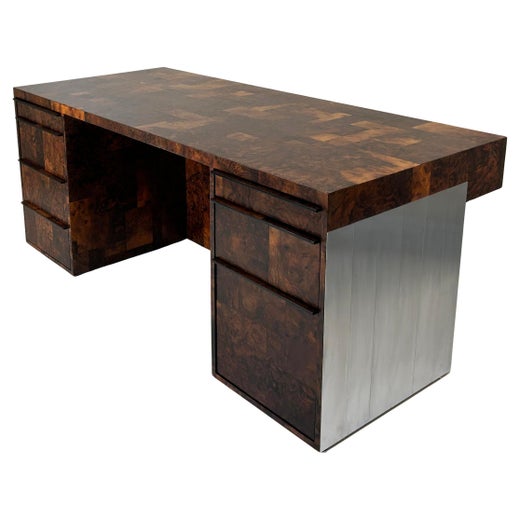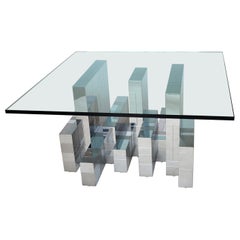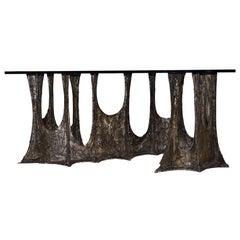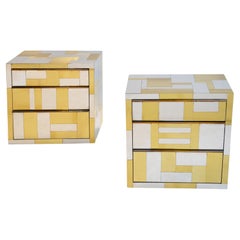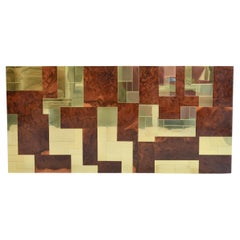Flip Top Bar Cabinet by Paul Evans
About the Item
- Creator:Paul Evans (Designer)
- Dimensions:Height: 36 in (91.44 cm)Width: 36 in (91.44 cm)Depth: 18 in (45.72 cm)
- Materials and Techniques:
- Place of Origin:
- Period:
- Date of Manufacture:1970's
- Condition:Brass: couple minor dings and needs to be polished. Our collection is "vintage" and not "new" therefore due to the natural aging process and use of the material, expect minor flaws and imperfections, including restored and refinished pieces. Please contact us to request a detailed condition report for this item.
- Seller Location:Fort Lauderdale, FL
- Reference Number:1stDibs: U1206048850224
Paul Evans
A designer and sculptor, Paul Evans was a wild card of late 20th century modernism. A leading light of the American Studio Furniture movement, Evans’s sideboards, credenzas, coffee tables and other work manifests a singular aesthetic sense, as well as a seemingly contradictory appreciation for both folk art forms and for new materials and technologies.
Evans’s primary material was metal, not wood, which was favored by his fellow studio designers, and Bucks County, Pennsylvania, neighbors George Nakashima and Phillip Lloyd Powell. He trained in metallurgy and studied at the Cranbrook Academy of Art, the famed crucible of modern design and art in suburban Detroit. For a time early in his career, Evans also worked at Sturbridge Village, a historical “living museum” in Massachusetts, where he gave demonstrations as a costumed silversmith.
Evans’s earliest work unites these influences. The pieces that made his reputation are known as “sculpted-front” cabinets: wood cases faced with box-like high-relief patinated steel mounts laid out in a grid pattern. Each mount contains a metal emblem, or glyph, and the effect is that of a brawny quilt.
Evans’s later work falls into three distinct style groups. His sculpted-bronze pieces, begun in the mid-1960s, show Evans at his most expressive. He employed a technique in which resin is hand-shaped, and later sprayed with a metal coating, allowing for artistic nuance in the making of chairs, tables and case pieces. Later in the decade and into the 1970s, Evans produced his Argente series for celebrated manufacturer Directional (a brand known to vintage mid-century modern furniture collectors everywhere): consoles and other furniture forms that feature aluminum and pigment-infused metal surfaces welded into abstract organic forms and patterns.
Last, Evans's Cityscape design series — a milestone in the history of brutalist design — meshed perfectly with the sleek, “high tech” sensibility of the later ’70s. Evans constructed boxy forms and faced them with irregular mosaic patterns that mixed rectangular plaques of chromed steel, bronze or burlwood veneer. These, like all of Paul Evans’s designs, are both useful and eye-catching. But their appeal has another, more visceral quality: these pieces have clearly been touched by an artist’s hand.
Find a collection of authentic Paul Evans furniture today on 1stDibs.
You May Also Like
Mid-20th Century American Mid-Century Modern Dry Bars
Burl
Mid-20th Century American Mid-Century Modern Cabinets
Formica, Wood, Lacquer
Vintage 1970s American Mid-Century Modern Dry Bars
Bronze
Vintage 1960s Mid-Century Modern Dry Bars
Chrome
Mid-20th Century American Mid-Century Modern Cabinets
Slate, Brass, Gold Leaf
Vintage 1930s French Country Cabinets
Oak
Vintage 1950s American Mid-Century Modern Cabinets
Aluminum
Vintage 1970s Organic Modern Dry Bars
Brass
Mid-20th Century American Rustic Cabinets
Brass
21st Century and Contemporary Slovak Modern Cabinets
Steel
More From This Seller
View AllMid-20th Century American Modern Coffee and Cocktail Tables
Chrome
Vintage 1970s American Mid-Century Modern Dining Room Tables
Bronze, Metal
Vintage 1970s American Modern Commodes and Chests of Drawers
Brass, Chrome
Vintage 1970s American Mid-Century Modern Beds and Bed Frames
Brass
Vintage 1980s Swedish Gustavian Cabinets
Glass, Oak, Teak
Mid-20th Century American Brutalist Abstract Sculptures
Sheet Metal
